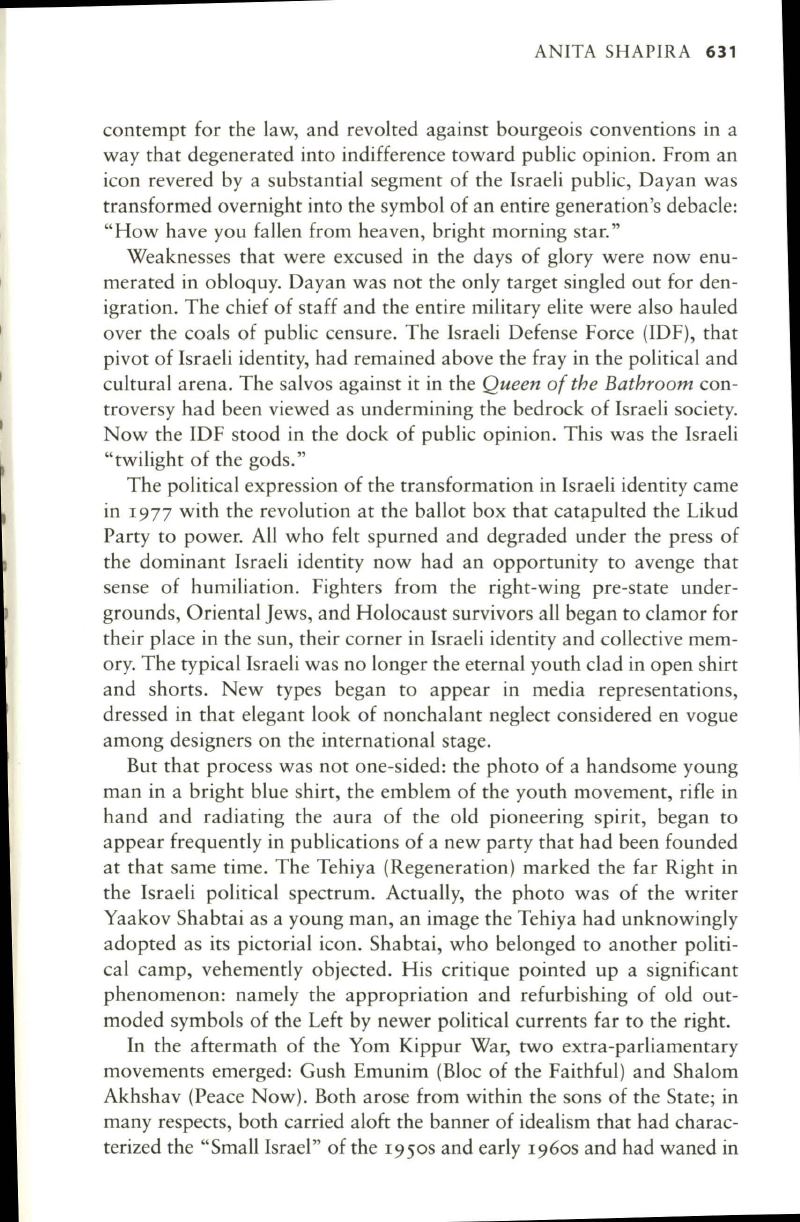
ANITA SHAPIRA
631
contempt for the law, and revolted against bourgeois conventions in a
way that degenerated into indifference toward public opinion. From an
icon revered by a substantial segment of the Israeli public, Dayan was
transformed overnight into the symbol of an entire generation's debacle:
"How have you fallen from heaven, bright morning star."
Weaknesses that were excused in the days of glory were now enu–
merated in obloquy. Dayan was not the only target singled out for den–
igration. The chief of staff and the entire military elite were also hauled
over the coals of public censure. The Israeli Defense Force (IDF), that
pivot of Israeli identity, had remained above the fray in the political and
cultural arena. The salvos against it in the
Queen of the Bathroom
con–
troversy had been viewed as undermining the bedrock of Israeli society.
Now the
IDF
stood in the dock of public opinion. This was the Israeli
"twilight of the gods."
The political expression of the transformation in Israeli identity came
in I977 with the revolution at the ballot box that catapulted the Likud
Party to power. All who felt spurned and degraded under the press of
the dominant Israeli identity now had an opportunity to avenge that
sense of humiliation. Fighters from the right-wing pre-state under–
grounds, Oriental Jews, and Holocaust survivors all began to clamor for
their place in the sun, their corner in Israeli identity and collective mem–
ory. The typical Israeli was no longer the eternal youth clad in open shirt
and shorts. New types began to appear in media representations,
dressed in that elegant look of nonchalant neglect considered en vogue
among designers on the international stage.
But that process was not one-sided: the photo of a handsome young
man in a bright blue shirt, the emblem of the youth movement, rifle in
hand and radiating the aura of the old pioneering spirit, began to
appear frequently in publications of a new party that had been founded
at that same time. The Tehiya (Regeneration) marked the far Right in
the Israeli political spectrum. Actually, the photo was of the writer
Yaakov Shabtai as a young man, an image the Tehiya had unknowingly
adopted as its pictorial icon. Shabtai, who belonged
to
another politi–
cal camp, vehemently objected. His critique pointed up a significant
phenomenon: namely the appropriation and refurbishing of old out–
moded symbols of the Left by newer political currents far to the right.
In
the aftermath of the Yom Kippur War, two extra-parliamentary
movements emerged: Gush Emunim (Bloc of the Faithful) and Shalom
Akhshav (Peace Now). Both arose from within the sons of the State; in
many respects, both carried aloft the banner of idealism that had charac–
terized the "Small Israel" of the I950S and early I960s and had waned in


